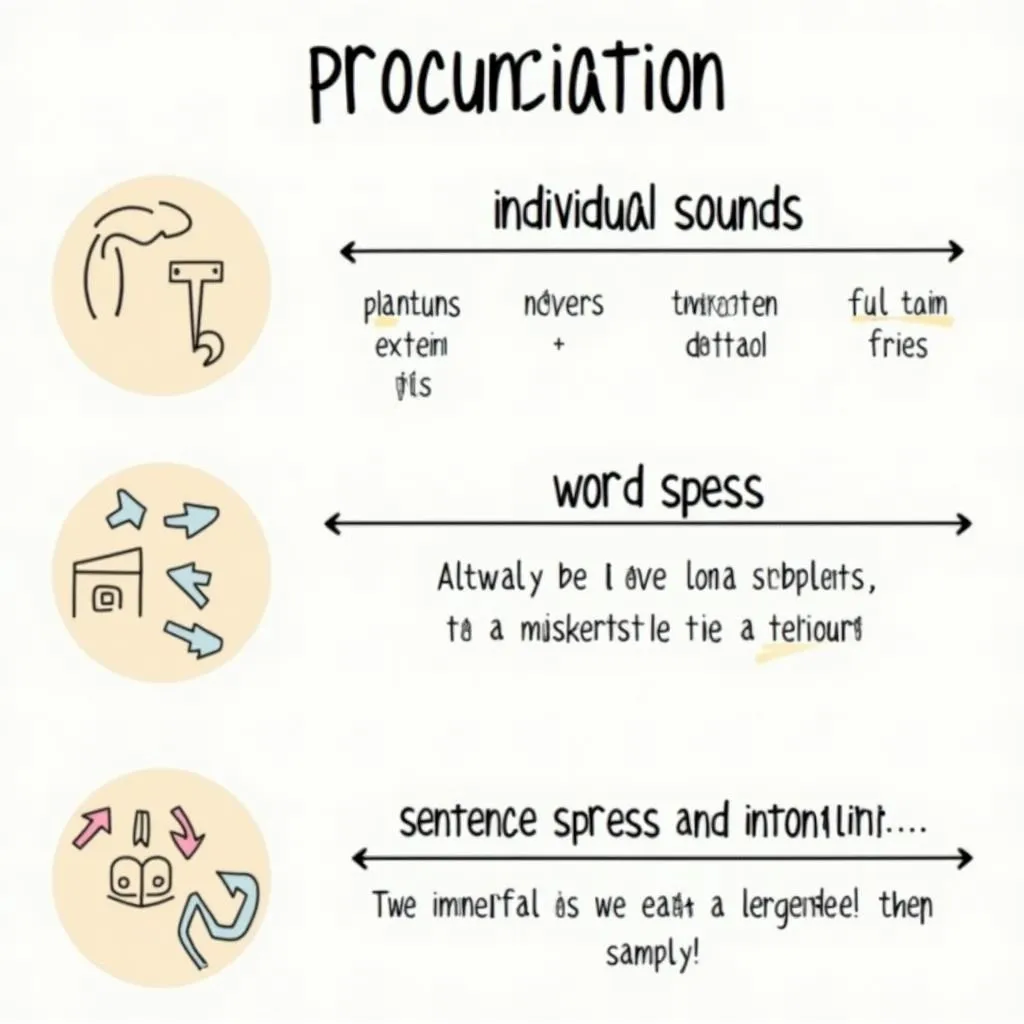Mastering pronunciation is crucial for success in the PTE Speaking section. This comprehensive guide will provide you with effective strategies and practical exercises to enhance your pronunciation skills, boosting your confidence and increasing your chances of achieving a high score in the PTE Academic exam.
Understanding the Importance of Pronunciation in PTE Speaking
Pronunciation plays a vital role in the PTE Speaking tasks, directly impacting your score in oral fluency and pronunciation. Clear and accurate pronunciation not only helps you communicate effectively but also demonstrates your language proficiency to the examiner.
How to interpret PTE score reports can provide valuable insights into your pronunciation strengths and areas for improvement.
Key Aspects of Pronunciation to Focus On
1. Individual Sounds
Mastering individual sounds is the foundation of good pronunciation. Pay attention to:
- Vowel sounds
- Consonant sounds
- Diphthongs (combined vowel sounds)
2. Word Stress
Placing emphasis on the correct syllable is crucial for clear pronunciation. Practice:
- Identifying stressed syllables in multi-syllable words
- Recognizing stress patterns in common word families
3. Sentence Stress and Intonation
These elements add meaning and emotion to your speech:
- Emphasizing content words in sentences
- Using rising and falling intonation appropriately
 Key aspects of pronunciation for PTE Speaking
Key aspects of pronunciation for PTE Speaking
Effective Techniques to Improve Your Pronunciation
-
Listen and Repeat
- Use native speaker recordings or podcasts
- Focus on mimicking not just words, but also intonation and rhythm
-
Record Yourself
- Compare your pronunciation with native speakers
- Identify areas for improvement
-
Use Pronunciation Apps
- Try apps like ELSA Speak or Pronunciation Coach
- Get instant feedback on your pronunciation
PTE speaking practice apps can be excellent tools for improving your pronunciation on the go.
-
Practice Minimal Pairs
- Focus on words that differ by only one sound
- Example: “ship” vs. “sheep”, “bat” vs. “pat”
-
Use a Mirror
- Observe your mouth and lip movements
- Ensure proper positioning for different sounds
-
Learn the International Phonetic Alphabet (IPA)
- Understand the symbols representing different sounds
- Use IPA to learn correct pronunciation from dictionaries
Dr. Emma Thompson, a renowned phonetics expert, states: “Understanding the IPA is like learning the alphabet of pronunciation. It gives you a precise tool to decode and reproduce any sound in English.”
 Techniques for improving pronunciation in PTE Speaking
Techniques for improving pronunciation in PTE Speaking
Targeted Exercises for PTE Speaking Pronunciation
Tongue Twisters
Practice these challenging phrases to improve articulation:
- “She sells seashells by the seashore.”
- “Peter Piper picked a peck of pickled peppers.”
- “How much wood would a woodchuck chuck if a woodchuck could chuck wood?”
Shadowing Technique
- Choose a short audio clip from a native speaker
- Listen to the clip several times
- Try to speak along with the audio, mimicking the speaker’s pace and intonation
- Gradually increase the length and complexity of the audio clips
PTE speaking module oral fluency exercises can provide additional practice to enhance your overall speaking performance.
Rhythm and Stress Practice
- Identify content words (nouns, verbs, adjectives, adverbs) in a sentence
- Practice saying the sentence, emphasizing only the content words
- Gradually add back function words (articles, prepositions, auxiliaries) while maintaining the rhythm
Professor Michael Chen, a PTE Speaking coach, advises: “Mastering rhythm and stress is like learning the music of English. It’s not just about individual notes, but how they flow together to create meaning.”
Incorporating Pronunciation Practice into Your PTE Preparation
To effectively improve your pronunciation for the PTE Speaking section:
- Dedicate daily practice time specifically for pronunciation
- Integrate pronunciation exercises into your overall PTE study plan
- Seek feedback from native speakers or language exchange partners
- Use authentic materials like news broadcasts or TED Talks for practice
How to practice speaking in exam-like conditions for PTE can help you apply your improved pronunciation skills in a test-like environment.
 Incorporating pronunciation practice into PTE preparation
Incorporating pronunciation practice into PTE preparation
Common Pronunciation Challenges for PTE Test-Takers
Be aware of these frequent issues:
- Th-sounds: Practice the difference between /θ/ (think) and /ð/ (this)
- Vowel length: Distinguish between short and long vowels (e.g., ship vs. sheep)
- Word endings: Pay attention to final consonants, especially -ed and -s endings
- Schwa sound: Master the neutral vowel sound in unstressed syllables
Conclusion
Improving your pronunciation for the PTE Speaking section requires consistent practice and targeted techniques. By focusing on individual sounds, word stress, and sentence intonation, you can significantly enhance your overall speaking performance. Remember to incorporate a variety of exercises and use technology to your advantage. With dedication and the right approach, you’ll be well on your way to achieving your desired score in the PTE Academic exam.
PTE preparation at home can be an effective way to continue working on your pronunciation skills in a comfortable environment.
FAQ
How long does it take to improve pronunciation for PTE Speaking?
Improvement time varies, but with consistent daily practice, noticeable progress can be seen in 4-6 weeks.
Can accent reduction help with PTE Speaking scores?
While accent reduction can help, focus on clarity and intelligibility rather than eliminating your accent entirely.
Are there any quick fixes for pronunciation in PTE Speaking?
There are no quick fixes, but practicing minimal pairs and focusing on commonly mispronounced words can yield rapid improvements.
How important is pronunciation compared to other aspects of PTE Speaking?
Pronunciation is crucial, but it’s equally important to focus on fluency, coherence, and content in your responses.
Can watching English movies and TV shows help improve pronunciation for PTE?
Yes, exposure to native speech through media can significantly improve your ear for correct pronunciation and intonation.
Is it necessary to learn the International Phonetic Alphabet (IPA) for PTE Speaking?
While not mandatory, understanding IPA can greatly enhance your ability to learn and produce correct pronunciations.